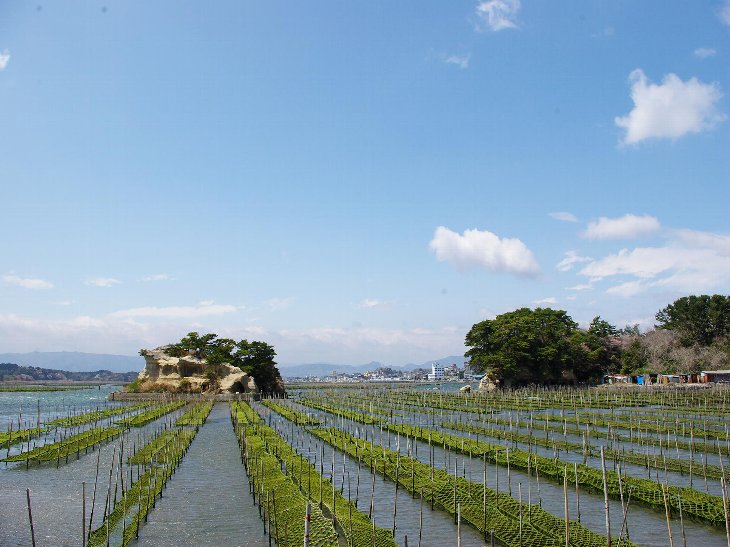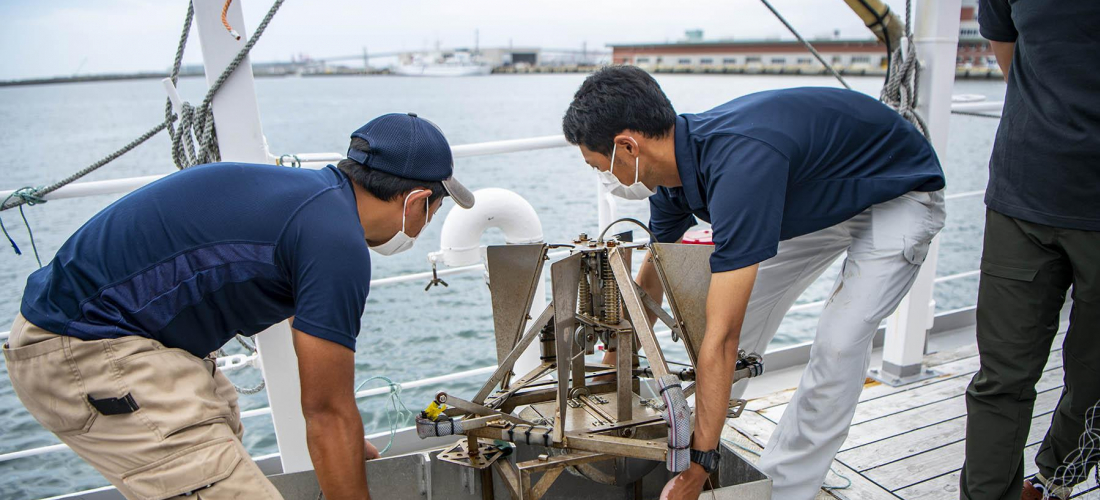
CONTENTS
The Fukushima city of Soma, in the northern Soso area of the coastal Hama-dori region, has distinct traditions and natural beauty, different from those in southern Iwaki.
Climate, Nature, Cuisine, and Tradition – Soma Is “A Gleaming City”
The City of Soma, in the northeast corner of Fukushima, is cool in the summer and warm in the winter. Despite its location in the northern part of Fukushima, known for snow in the colder months, Soma's place right on the Pacific Ocean means the area has a mild climate that's easy to live in.
The city is wedged between inland mountains and the open sea, and Soma's Matsukawaura Prefectural Natural Park (松川浦県立自然公園) contains the only lagoon on Fukushima's coastline―named one of Japan's 100 most famous scenic views! The lagoon is home to all sorts of rare species, and it's a popular resting place for many kinds of migratory birds. Aside from admiring the local wildlife, visitors can check out the striking shapes of the islands dotting the water, often compared to Matsushima―one of Japan's "top three" scenic views. The Matsukawaura lagoon's islands bear a strong enough resemblance to the more famous destination that some of them are called "Komatsushima" (小松島, little Matsushima). Whether the water is glittering in the morning sun, or dyed pink at sunset, the lagoon makes for a beautiful view.
Soma Nomaoi Festival – The Product of Centuries of Tradition
The Soma Nomaoi (相馬野馬追) is a festival that owes its fame to the Soma clan (相馬氏), the line of samurai who wielded power over the region for 700 years, from Japan's Kamakura period (1185~1333) to the Meiji period (1868~1912). The Soma clan not only gave the area its name, they also gifted the city with the rituals of the Soma Nomaoi, an official Important Intangible Folk Cultural Property, and a well-known traditional festival known around Japan. Nomaoi quite literally means "wild horse chase," and after multiple days of festive horse riding in period armor and traditional military-style processions, the celebrations end each year with a ritual where young riders catch a wild horse and present it to a Shinto shrine as a "shinme" (神馬, a sacred horse)―a tradition stretching back to historic times. It's a fascinating cultural experience, and the spectacle of strikingly-dressed "samurai" rushing around on horseback makes attending the festivities feel like traveling back in time to the years of the Sengoku period (1467~1615).
Packed With Delicious Flavors, From Sea to Solid Ground
In the kitchens of Soma, delicacies from both the ocean and the mountains cozy up to each other, becoming tasty local cuisine. The region is a hotspot for top-level produce and food products, like rice that has won gold medals at international conventions, soy sauce that has earned top scores at national competitions for years, and specialty free range eggs―plus plenty of other produce, like strawberries and pears.
Above all else, much like the nearby city of Iwaki, Soma's gourmet scene is really known for its high-quality fish and seafood, called Fukushima Joban-mono (福島常磐もの). Throughout the city, restaurants and ryokan use the freshest ingredients straight from that day's catch, including some rarer varieties of seafood. Visitors shouldn't miss the chance to indulge in meals made from locally caught monkfish, flounder of all kinds, donko (どんこ or dark sleeper goby), sandlance, octopus, Sakhalin surf clam, whelk, and even snow crab.
In addition, aquaculture farms in Matsukawaura lagoon grow huge swaths of nori (green laver seaweed), which is added to miso soup, fried up as tempura, and even pickled. But the nori isn't just good to eat―in autumn, bamboo stakes are lined up and stuck into the sand throughout the lagoon, and at the height of the harvest in winter and spring, travelers can take in the verdant views of seaweed growing on nets spread out like lush green carpet.
A City of Sports, Regulation Fields, & Courts
Sports tourism is a big thing in Soma, so the city is scattered with sports facilities that anyone can enjoy. Matsukawaura Park Golf Course has a whole nine courses and 81 holes overlooking the lagoon, and is officially recognized by the Nippon Park Golf Association, while Koyo Soma Soccer Field has a natural grass field alongside an artifical grass field, in line with both the Japan Football Association and FIFA 2 Star regulations. Sand-filled artificial grass tennis courts in the city are even open at night, so players can swing their rackets under the stars. Travelers looking for facilities to play some less casual sports will also find softball fields and more, available throughout the year.
Two Hama-dori Cities With a Harmonious Balance of Nature, Tradition, and Food
The gentle climate, the bounty of the sea and the earth, the footprints of history… Iwaki and Soma, two cities with their own personalities, are both prime examples of all the Hama-dori coastal region has to offer. And when it comes to similarities, the abundant seas and fresh seafood are clearly common to both Soma and Iwaki. In Japanese, they might even use the phrase "umi no sachi" (海の幸) to describe the cities' daily catch―literally the "fortune of the sea."
In the next few articles of our "Just what is Joban-mono fish?" series, we'll be taking a deeper look at the food culture and cuisine originating in Iwaki, Soma, and the surrounding seas. After spending time in Soma and Iwaki and getting a real feel for the area, the Japankuru team is ready to tell you all about what is being brought out of the ocean, how that fish and seafood makes its way to the market, and everything to do with preparing and enjoying the local cuisine. If you're wondering―we'll also be explaining the real safety policies and procedures concerning seafood being put into practice all along Fukushima's coast, so you can see for yourself what's going on. Don't miss it!
Keep an eye out on Japankuru for more on Fukushima coming soon, and for more info and updates from Japan, follow us on twitter, instagram, and facebook!













 >> Find out more at Japankuru.com! (link in bio)
#
>> Find out more at Japankuru.com! (link in bio)
#





 The Robot Restaurant is gone, but the Samurai Restaurant is here to take its place. Check it out, and don't forget your coupon!
The Robot Restaurant is gone, but the Samurai Restaurant is here to take its place. Check it out, and don't forget your coupon!
 신주쿠의 명소 로봇 레스토랑이 사무라이 레스토랑으로 부활! 절찬 쿠폰 발급중
신주쿠의 명소 로봇 레스토랑이 사무라이 레스토랑으로 부활! 절찬 쿠폰 발급중
 18歲以上才能入場的歌舞秀,和你想的不一樣!拿好優惠券去看看~
#tokyo #shinjuku #samurairestaurant #robotrestaurant #tokyotrip #도쿄여행 #신주쿠 #사무라이레스토랑 #이색체험 #할인이벤트 #歌舞伎町 #東京景點 #武士餐廳 #日本表演 #日本文化體驗 #japankuru #japantrip #japantravel #japanlovers #japan_of_insta
18歲以上才能入場的歌舞秀,和你想的不一樣!拿好優惠券去看看~
#tokyo #shinjuku #samurairestaurant #robotrestaurant #tokyotrip #도쿄여행 #신주쿠 #사무라이레스토랑 #이색체험 #할인이벤트 #歌舞伎町 #東京景點 #武士餐廳 #日本表演 #日本文化體驗 #japankuru #japantrip #japantravel #japanlovers #japan_of_insta
 코지마 x 빅 카메라 쿠폰으로 일본 가전 제품 쇼핑하기
#pr #japankuru #japanshopping #kojima #biccamera #japaneseskincare #yaman #dji #osmopocket3 #skincaredevice #日本購物 #美容儀 #相機 #雅萌 #日本家電 #일본여행 #면세 #여행꿀팁 #일본쇼핑리스트 #쿠폰 #일본쇼핑 #일본브랜드 #할인 #코지마 #빅카메라 #japankurucoupon
코지마 x 빅 카메라 쿠폰으로 일본 가전 제품 쇼핑하기
#pr #japankuru #japanshopping #kojima #biccamera #japaneseskincare #yaman #dji #osmopocket3 #skincaredevice #日本購物 #美容儀 #相機 #雅萌 #日本家電 #일본여행 #면세 #여행꿀팁 #일본쇼핑리스트 #쿠폰 #일본쇼핑 #일본브랜드 #할인 #코지마 #빅카메라 #japankurucoupon























































